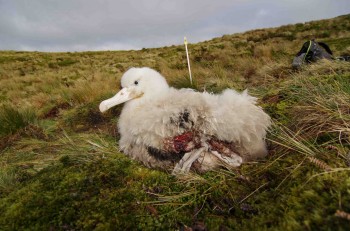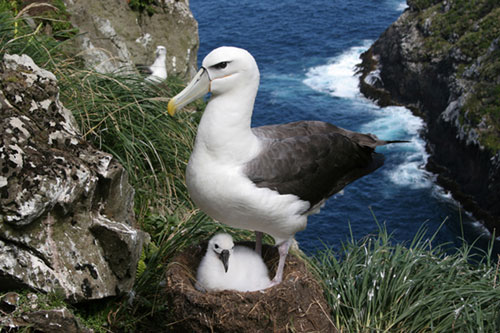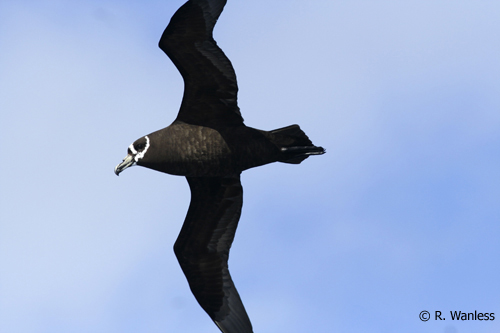A team of 50 authors from 40 institutions led by Nick Holmes (Island Conservation, Santa Cruz, California, USA) has published open access in the online journal PLOS ONE on the results of analysing a data set of 1279 islands worldwide whose Endangered and Critically Endangered vertebrate species are at risk of local extinction from introduced mammals.
Four of the highest conservation-value islands featured which provide key breeding grounds for populations of ACAP-listed albatrosses, petrels and shearwaters are Robinson Crusoe (Chile), Amsterdam (France), Guadalupe (Mexico) and Gough (UK).

A Critically Endangered Tristan Albatross Diomedea dabbenena chick on Gough Island is slowly dying after overnight attacks by introduced House Mice
Photograph by Karen Bourgeois/Sylvain Dromzee
Other islands with breeding populations of ACAP-listed species identified as globally important conservation opportunities for invasive mammal eradications in the publication are Mocha (Chile), Plata (Ecuador), three Crozet Islands (Cochons, Est and Possession, France), Saint-Paul (France), Auckland (main island), Great Barrier/Aotea (New Zealand), Marion (South Africa), five Balearic Islands (Cabrera Gran, Conillera, Espalmador, Espartar and Tagomago, Spain), Tristan da Cunha (main island, UK), and Lehua (confirmation of Polynesian Rat Rattus exulans eradication awaited) and Sand Island, Midway Atoll (both USA).
Eradication efforts are currently in the planning stages for Gough, Marion and Midway (all directed at House Mice Mus musculus) and for Auckland Island (feral cats, feral pigs and House Mice). Research on Amsterdam Island's introduced mammals (feral cats and rodents) commenced last year towards informing planning for possible future eradications (click here). South Georgia (Islas Georgias del Sur)* is included on the paper’s list of islands but has now been declared free of invasive mammals following successful eradication campaigns against rodents and Reindeer Rangifer tarandus. In correspondence with ACAP Latest News, the publication’s senior author explains that France’s sub-Antarctic Kerguelen Islands, which support both important populations of a number of ACAP-breeding species and invasive mammals, were considered but are not included because overall they exceeded the maximum island size for the analysis conducted.
The paper’s abstract follows:
“Invasive alien species are a major threat to native insular species. Eradicating invasive mammals from islands is a feasible and proven approach to prevent biodiversity loss. We developed a conceptual framework to identify globally important islands for invasive mammal eradications to prevent imminent extinctions of highly threatened species using biogeographic and technical factors, plus a novel approach to consider socio-political feasibility. We applied this framework using a comprehensive dataset describing the distribution of 1,184 highly threatened native vertebrate species (i.e. those listed as Endangered or Critically Endangered on the IUCN Red List) and 184 non-native mammals on 1,279 islands worldwide. Based on extinction risk, irreplaceability, severity of impact from invasive species, and technical feasibility of eradication, we identified and ranked 292 of the most important islands where eradicating invasive mammals would benefit highly threatened vertebrates. When socio-political feasibility was considered, we identified 169 of these islands where eradication planning or operation could be initiated by 2020 or 2030 and would improve the survival prospects of 9.4% of the Earth’s most highly threatened terrestrial insular vertebrates (111 of 1,184 species). Of these, 107 islands were in 34 countries and territories and could have eradication projects initiated by 2020. Concentrating efforts to eradicate invasive mammals on these 107 islands would benefit 151 populations of 80 highly threatened vertebrates and make a major contribution towards achieving global conservation targets adopted by the world’s nations.”

Near Threatened White-capped Albatross Thalassarche steadi on Auckland Island: at risk to feral cats and pigs, photograph by David Thompson
Read popular accounts written from different perspectives of the publication from the BBC, Guardian, Island Conservation, New Zealand Herald and the Royal Society for the Protection of Birds.
With thanks to Nick Holmes, Island Conservation.
Reference:
Holmes, N.D., Spatz, D.R., Oppel, S., Tershy, B., Croll, D.A., Keitt, B. et al. 2019. Globally important islands where eradicating invasive mammals will benefit highly threatened vertebrates. PLOS ONE 14(3) & supporting information. doi.org/10.1371/journal. pone.0212128.
John Cooper, ACAP Information Officer, 11 April 2019
*A dispute exists between the Governments of Argentina and the United Kingdom of Great Britain and Northern Ireland concerning sovereignty over the Falkland Islands (Islas Malvinas), South Georgia and the South Sandwich Islands (Islas Georgias del Sur y Islas Sandwich del Sur) and the surrounding maritime areas.


 English
English  Français
Français  Español
Español 



